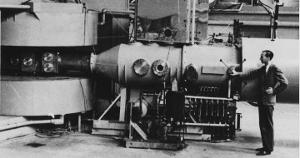The chemical element mendelevium is classed as actinide metal. It was discovered in 1955 by Albert Ghiorso, Bernard Harvey, Gregory Choppin, Stanley Thompson, and Glenn Seaborg.

Data Zone
| Classification: | Mendelevium is an actinide metal |
| Color: | |
| Atomic weight: | (258), no stable isotopes |
| State: | solid |
| Melting point: | 827 oC, 1100 K |
| Boiling point: | |
| Electrons: | 101 |
| Protons: | 101 |
| Neutrons in most abundant isotope: | 157 |
| Electron shells: | 2,8,18,32,31,8,2 |
| Electron configuration: | [Rn] 5f12 7s2 |
| Density @ 20oC: |
Reactions, Compounds, Radii, Conductivities
| Atomic volume: | – |
| Structure: | close packed cubic |
| Hardness: | – |
| Specific heat capacity | – |
| Heat of fusion | – |
| Heat of atomization | – |
| Heat of vaporization | – |
| 1st ionization energy | 635 kJ mol-1 |
| 2nd ionization energy | – |
| 3rd ionization energy | – |
| Electron affinity | – |
| Minimum oxidation number | 0 |
| Min. common oxidation no. | 0 |
| Maximum oxidation number | 3 |
| Max. common oxidation no. | 3 |
| Electronegativity (Pauling Scale) | 1.3 |
| Polarizability volume | 18.2 Å3 |
| Reaction with air | |
| Reaction with 15 M HNO3 | |
| Reaction with 6 M HCl | |
| Reaction with 6 M NaOH | |
| Oxide(s) | |
| Hydride(s) | – |
| Chloride(s) | |
| Atomic radius | – |
| Ionic radius (1+ ion) | – |
| Ionic radius (2+ ion) | – |
| Ionic radius (3+ ion) | 89.6 pm |
| Ionic radius (1- ion) | – |
| Ionic radius (2- ion) | – |
| Ionic radius (3- ion) | – |
| Thermal conductivity | – |
| Electrical conductivity | – |
| Freezing/Melting point: | 827 oC, 1100 K |

Many transuranium elements including mendelevium were discovered using the 60-inch cyclotron at the University of California Lawrence Radiation Laboratory, Berkeley.
Discovery of Mendelevium
Mendelevium was the ninth synthetic transuranium element of the actinide series to be discovered.
It was first identified by Albert Ghiorso, Bernard Harvey, Gregory Choppin, Stanley Thompson, and Glenn Seaborg in 1955 at the Lawrence Berkeley National Laboratory, California.
Mendelevium-256 (half-life 78.1 minutes) was produced by bombarding einsteinium-253 with alpha particles in the Berkeley 60-inch cyclotron.
Only 17 atoms of mendelevium-256 were initially produced in an all night experiment predicted to produce just one or two atoms of product every three hours. Each nuclear reaction created mendelevium-256 and a neutron. (1), (2), (3)
Mendelevium was identified by chemical analysis in an ion exchange experiment. (1)
The element is named after the Russian chemist Dmitri Mendeleev who devised the first periodic table in modern form.
Appearance and Characteristics
Harmful effects:
Mendelevium is harmful due to its radioactivity.
Characteristics:
Mendelevium is a synthetic, highly radioactive metal and has only been produced in miniscule amounts.
Mendelevium was the first element to be produced one atom at a time.
Mendelevium metal has not been prepared. (3)
Uses of Actinium
Mendelevium is of scientific research interest only.
Abundance and Isotopes
Abundance earth’s crust: nil
Abundance solar system: –
Cost, pure: $ per g
Cost, bulk: per 100g
Source: Mendelevium is a synthetic element and is not found naturally. Mendelevium is produced through charged-particle of lighter elements in particle accelerators.
Isotopes: Mendelevium has 16 isotopes whose half-lives are known, with mass numbers 245 to 260. Mendelevium has no naturally occurring isotopes. Its longest lived isotopes are 258Md with a half-life of 51.5 days, 260Md, with a half-life of 31.8 days and 259Md with a half-life of 96 minutes.

References
- Glenn 1. Seaborg, The Transcalifornium Elements., Journal of Chemical Education, Vol 36.1 (1959) p39.
- John Emsley, Nature’s building blocks: an A-Z guide to the elements., Oxford University Press, 2003., p458.
- Robert J. Silva, The Chemistry of the Actinide and Transactinide Elements., Springer., Vol 3.13, p1630 – 1634.
Cite this Page
For online linking, please copy and paste one of the following:
<a href="https://www.chemicool.com/elements/mendelevium.html">Mendelevium</a>
or
<a href="https://www.chemicool.com/elements/mendelevium.html">Mendelevium Element Facts</a>
To cite this page in an academic document, please use the following MLA compliant citation:
"Mendelevium." Chemicool Periodic Table. Chemicool.com. 17 Oct. 2012. Web. <https://www.chemicool.com/elements/mendelevium.html>.